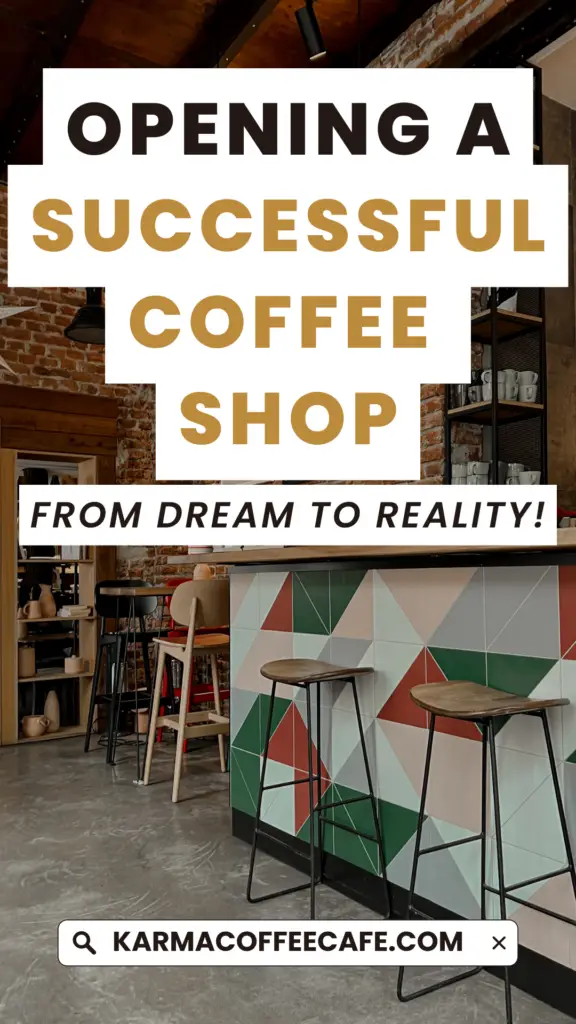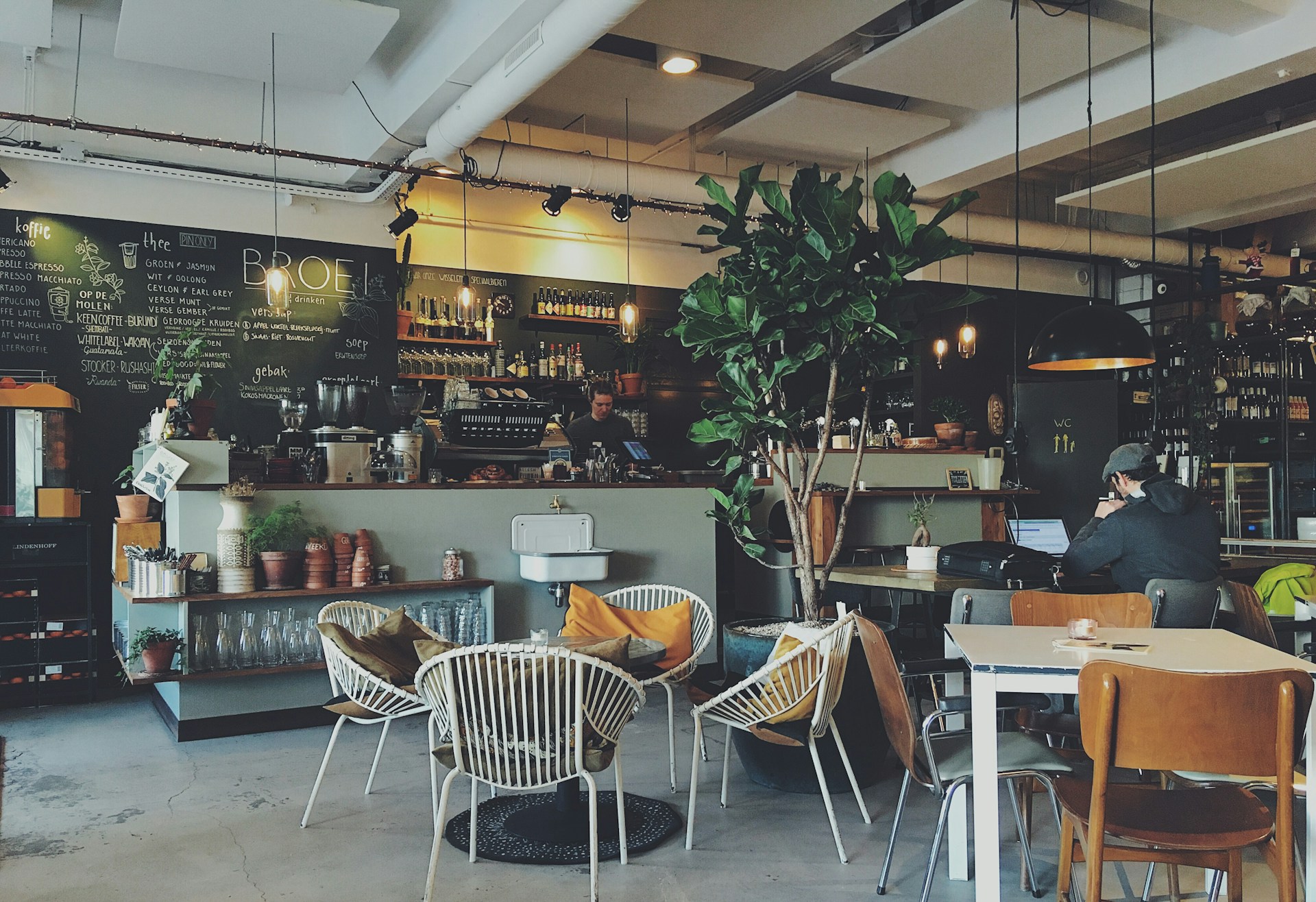The coffee shop industry is thriving, growing faster than many other sectors.
Each day, more entrepreneurs are drawn to this vibrant market, where the aroma of freshly brewed coffee can turn a modest shop into a community hub.
The global coffee shop market is estimated to be worth $237.6 billion in 2021 and is expected to grow exponentially in the coming years.
According to Drive Research, 51% of people purchase coffee from a coffee shop at least once a week.
People are motivated to start their own coffee shops for various reasons.
Some are passionate about coffee and want to share that love with the world.
Others see it as an opportunity to create a cozy, inviting space where people can connect.
Whatever the reason, opening a coffee shop can be a rewarding venture, combining passion with profit.
Let’s explore what it takes to launch a successful coffee shop business.

1. Preliminary Steps Before Starting Your Coffee Shop

Understand the Coffee Shop Market
Before diving into the coffee shop business, it’s crucial to grasp the current trends and who your customers might be.
The coffee shop market is marked by a consistent growth of 7% annually, reflecting its increasing popularity and profitability.
This trend suggests a strong and expanding demand for coffee shops, making now a great time to consider starting your own.
Understanding who frequents coffee shops is just as important as knowing the market’s growth.
The market is notably popular among younger generations who favor gourmet and specially roasted coffee beans.
These customers are not just looking for a quick caffeine fix but a quality experience.
They appreciate a good brew and are willing to pay for premium products and a pleasant atmosphere.
Catering to this demographic can set the foundation for a loyal customer base that values quality and experience over convenience.
Conduct Market and Competition Analysis
To ensure your coffee shop stands out, it’s essential to conduct a thorough market and competition analysis.
Start by assessing the local demand.
This involves identifying if people in your area are interested in coffee shops and if there’s a gap in the market you can fill.
You might look at how many coffee drinkers there are locally and what kind of coffee or café environment they prefer.
Next, analyze your competitors.
This means looking at other coffee shops in the area to see what they offer.
Notice their menu, pricing, shop layout, and customer service.
Understanding what your competitors are doing well can help you learn from their successes.
However, pinpointing their shortcomings can offer you a chance to do better and attract their customers to your shop.
Choosing Your Coffee Shop Concept
Selecting the right concept for your coffee shop is a critical decision that shapes your brand and influences customer perception.
You can opt for an independent shop or a franchise, each offering distinct advantages.
An independent coffee shop allows for full creative control and the ability to provide a unique, personalized customer experience.
This model is perfect for those who have a specific vision and want to create a distinct atmosphere.
Alternatively, a franchise offers the benefit of a recognized brand and a proven business model, which can be reassuring and reduce some risks associated with starting a business.
Franchises often come with built-in customer bases and support from the franchise network, which can be invaluable for new entrepreneurs.
Within these models, you can choose from various themes, such as traditional, modern, or niche.
A traditional coffee shop might focus on classic coffee experiences with a cozy, homelike atmosphere, while a modern shop might prioritize sleek design and innovative technology, catering to a tech-savvy crowd.
Niche themes, like cat cafes or book-themed coffee shops, cater to specific interests, creating a unique environment where like-minded individuals can gather.
Your choice should reflect both your personal interests and the preferences of your target demographic, ensuring your coffee shop is a place they’ll want to return to time and again.
2. Laying the Foundation

Writing a Coffee Shop Business Plan
Creating a solid business plan is a foundational step in opening your coffee shop.
This document outlines your business strategy, goals, and details on how you plan to achieve them.
The key components of a business plan include:
- Executive summary
- Company description
- Market analysis
- Organization and management structure
- Sales strategies
- Funding requests
- Financial projections
The executive summary provides a snapshot of your business and its future direction.
It should be compelling enough to grab the interest of potential investors.
The company description goes deeper into what your coffee shop offers and what sets it apart from competitors.
Market analysis helps understand your target customers, local market trends, and how you stack up against the competition.
In the organization and management section, describe the structure of your business and the team that will run it.
Sales strategies should detail how you plan to attract and retain customers, while the funding request section outlines the financial requirements needed to start and grow your business.
Lastly, financial forecasting is crucial.
This section should include detailed projections for your startup costs, ongoing operating expenses, and revenue.
It should realistically reflect how your coffee shop expects to perform financially in the first few years.
A well-thought-out business plan not only guides your strategy but also shows potential investors that you have a clear path to profitability.
Securing Financing
You have several options to secure the necessary capital.
Loans, investors, and crowdfunding are the most common methods to gather financial resources.
First, consider small business loans from banks or financial institutions.
These loans can provide the bulk of the funds you might need but require detailed business plans and often, collateral.
Next, you can seek out investors.
These might be people who give you capital in exchange for a share in the business or future profits.
Investors can also bring valuable expertise and networks to your venture.
Crowdfunding is another viable option, especially for community-focused or unique concept coffee shops.
Platforms like Kickstarter allow you to raise money from the general public.
This method not only funds your business but also builds a customer base before you even open.
When it comes to budgeting, start by listing all expected startup costs such as location lease, renovations, equipment, initial inventory, and licensing fees.
Also, plan for ongoing expenses like utilities, supplies, payroll, and marketing.
Being thorough and realistic with your budget can help you manage finances effectively and avoid unexpected shortfalls.
Choosing the Right Location
Selecting the right location is critical for the success of your coffee shop.
Consider three main factors: foot traffic, competition, and accessibility.
Foot traffic is vital.
The more people that pass by your coffee shop, the higher the potential for walk-in customers.
Look for areas with high visibility and frequent pedestrian activity, such as city centers, busy streets, or near colleges and offices.
Competition in the area is also crucial.
Being close to other coffee shops isn’t always bad, as it can signify a strong market, but you’ll need a clear differentiation strategy.
Assess the saturation of the market and consider how you can offer something unique that draws customers to your shop instead.
Accessibility is about how easy it is for customers to reach your location.
This includes parking availability and proximity to public transportation.
An accessible shop can attract a broader range of customers, including those who might not pass by on foot but are willing to travel for a good coffee experience.
Lastly, consider the cost of rent.
It should be sustainable and not exceed 15% of your monthly sales to maintain profitability.
In a nutshell, securing a location that balances cost with the potential for high customer traffic is key to your coffee shop’s financial health and growth.
3. Legal and Administrative Requirements

Selecting Your Business Structure
The most common types of small businesses include sole proprietorship, partnership, limited liability company (LLC), and corporation.
A sole proprietorship is the simplest form, where the business is owned by one person.
This setup has minimal paperwork and allows you to have complete control.
However, it does not provide any personal liability protection, which means your personal assets could be at risk if your business is sued.
A partnership is similar to a sole proprietorship but involves two or more people.
It shares many of the same pros and cons, including the lack of personal liability protection for the partners.
An LLC is a popular choice among small business owners because it offers liability protection.
This means your personal assets are protected from business debts and claims.
An LLC is also flexible in taxation, allowing profits and losses to pass through to your personal income without facing corporate taxes.
A corporation is more complex and suited for businesses that plan to raise money through selling stock.
It provides the strongest protection against personal liability, but it requires more extensive record-keeping, operational processes, and potentially higher costs.
Each structure has its legal implications and tax responsibilities. It’s important to choose the one that best fits your business goals, size, and level of desired protection.
Consulting with a business attorney or accountant can provide personalized advice and help you navigate the specifics of your situation.
Obtaining Necessary Permits and Licenses
Securing the proper permits and licenses is essential before you can open your coffee shop.
This step ensures your business operates legally and complies with local regulations.
The most common permits include:
- A business license: Mandatory for any establishment that wants to conduct business.
- A food handler’s permit: Crucial for any entity serving food and drinks.
- Health department certifications: Ensures your coffee shop meets health and safety standards.
Depending on your location, you may also need a sign permit, building and construction permits for any renovations, and a seller’s permit, which allows you to collect sales tax from customers.
The timeframe for obtaining these permits can vary significantly.
It typically takes about four weeks, but this can be longer if additional inspections or reviews are required.
The process involves multiple authorities, from local health departments to city planning offices.
Each has its own set of requirements and processing times.
Starting the application process early is advisable to avoid delays.
Ensure you understand the specific requirements in your area by contacting local government offices or consulting with a legal expert.
4. Designing Your Coffee Shop
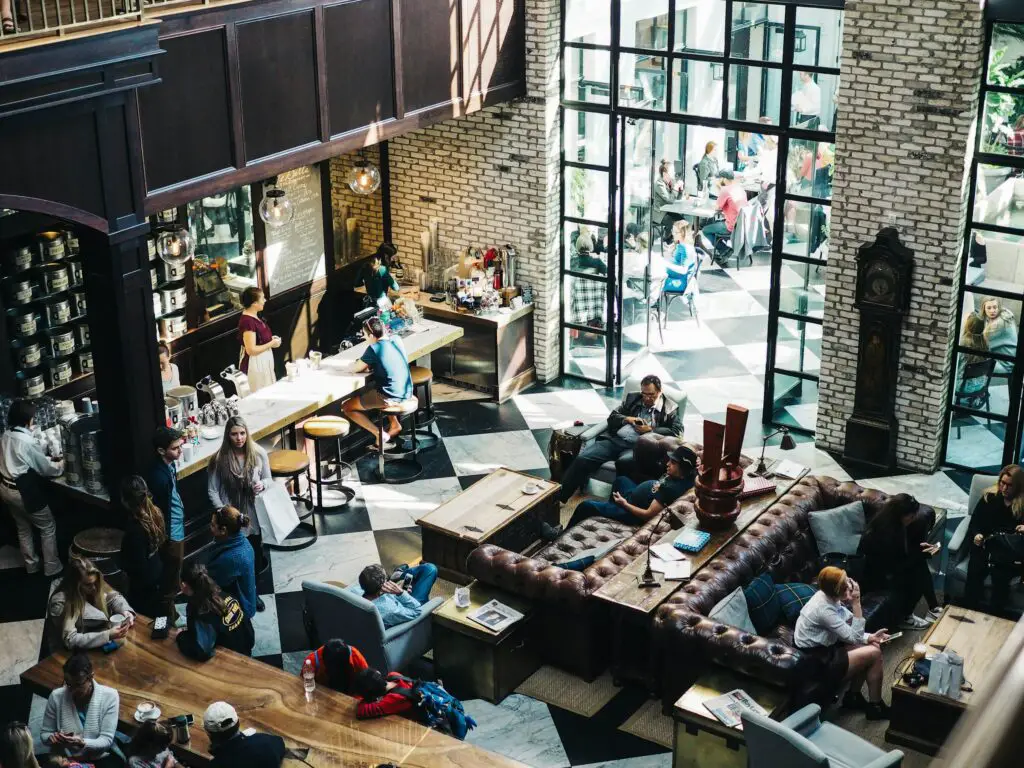
Designing an Effective Layout
Creating an effective layout for your coffee shop involves thoughtful planning of both the front-of-house and back-of-house areas.
This design impacts not only the aesthetics but also the functionality and customer experience.
In the front-of-house, where customers will spend most of their time, focus on creating a welcoming and comfortable atmosphere.
Consider the arrangement of seating to optimize space while avoiding overcrowding.
Pay attention to the flow of customer traffic: paths should be clear and logical from the entrance to the order counter, to the seating areas, and back to the exit.
This flow should naturally lead customers through your space, making it easy and intuitive for them to order and find a place to relax.
The back-of-house is where your coffee and food preparation takes place.
This area needs to be highly functional.
Design the layout to maximize efficiency and safety for staff.
Ensure there is enough space for equipment, storage, and movement without congestion.
Organize your kitchen layout to support a logical process from receiving ingredients, storing them, prepping, cooking, and finally serving.
This area should also accommodate all the necessary health and safety standards.
Overall, the goal is to balance aesthetics with functionality.
The design should enhance the customer’s experience by being visually appealing and comfortable, while also allowing your staff to work efficiently and safely in the back-of-house.
Hiring a professional designer who understands the unique needs of food service operations can be a worthwhile investment.
Choosing and Purchasing Equipment
Your essential equipment list typically includes:
- Commercial espresso machines
- Coffee grinders
- Blenders
- Refrigerators
- Dishwashers
- Ovens or toasters for any food offerings
When choosing equipment, focus on quality and reliability.
Commercial-grade equipment, while more expensive, can handle higher volumes and is usually more durable.
It’s essential to strike a balance between cost and quality.
Investing in high-quality equipment can reduce maintenance issues and improve the overall customer experience with faster service and consistent product quality.
When purchasing equipment, also consider the warranty and service terms.
Equipment with longer warranties and accessible service can save you significant amounts in the long run.
Also, check for energy efficiency ratings to help reduce your operating costs.
For choosing suppliers, look for reputable companies known for quality and service.
Ask other coffee shop owners for recommendations and read online reviews.
Attend trade shows to see the equipment in action and to compare different brands and models.
Establishing a good relationship with your suppliers can also lead to benefits like discounts, training for your staff on how to use the equipment, and quicker service if repairs are needed.
5. Building Your Brand and Menu
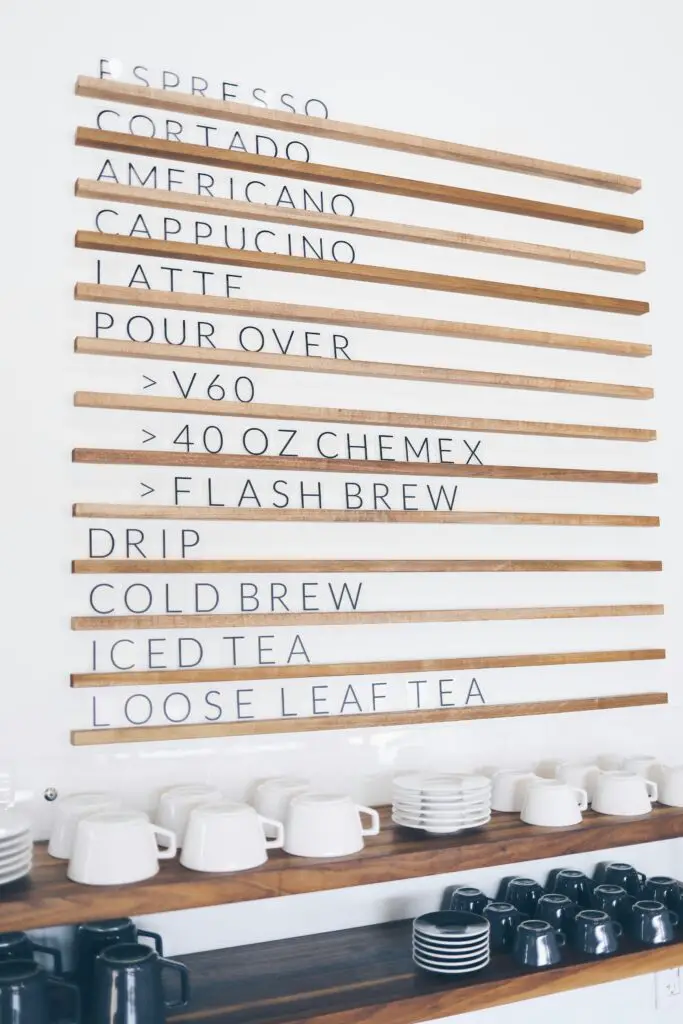
Developing a Branding Strategy
Establishing a strong branding strategy is essential for setting your coffee shop apart from the competition.
Your brand includes your logo, signage, and overall theme, which collectively communicate your coffee shop’s identity and values to customers.
Start with your logo, which should be distinctive yet simple enough to be easily recognizable.
It will appear on everything from your storefront to your coffee cups, so it should effectively convey the essence of your brand.
Consider hiring a professional graphic designer who can translate your vision into a visually appealing and memorable logo.
Signage is not just about your name displayed over the door; it’s a crucial element of your visual identity and the first point of contact with potential customers.
Ensure it is visible and readable from a distance and reflects the style and tone of your coffee shop.
Developing a theme involves more than choosing colors and furniture; it encompasses the entire customer experience, from decor to the music played and the style of customer service.
Your theme should resonate with your target audience and reinforce the brand story you want to tell.
Whether you’re creating a cozy, rustic space or a modern, sleek cafe, the theme should provide a consistent and inviting atmosphere.
Building a brand story is about creating a narrative that connects your coffee shop to your customers on an emotional level.
This story should speak to who you are, why you started your coffee shop, and what makes you different from others.
Effective storytelling can foster a strong sense of community and loyalty among your customers, making them feel like part of your coffee shop’s journey.
Crafting Your Coffee Menu
Your menu should offer a variety of options while maintaining focus, catering to a wide range of tastes, and being manageable for operations.
Start with menu planning strategies that highlight your strengths.
Focus on a few signature drinks that can set you apart from other coffee shops, whether it’s a unique blend, a seasonal special, or a creative concoction.
These signature items can become a draw for new customers and a favorite among regulars.
Incorporate a variety of coffee offerings to cater to different preferences.
Include options like espresso, cappuccino, latte, and some specialty beverages like mochas or flavored lattes.
Consider the trends in coffee consumption, such as cold brews or plant-based milk alternatives, to appeal to health-conscious or trendy consumers.
Don’t forget to include food offerings.
Pairing coffee with the right food can enhance the customer experience and increase sales.
Offer a mix of pastries, sandwiches, and perhaps some healthy options like salads or fruit bowls.
Make sure the food complements the coffee rather than overshadowing it.
Remember, the key to a successful coffee menu is in its alignment with your brand and your target audience’s preferences.
Regularly review and adjust your menu based on customer feedback and sales data to keep your offerings exciting and relevant.
6. Operational Strategies
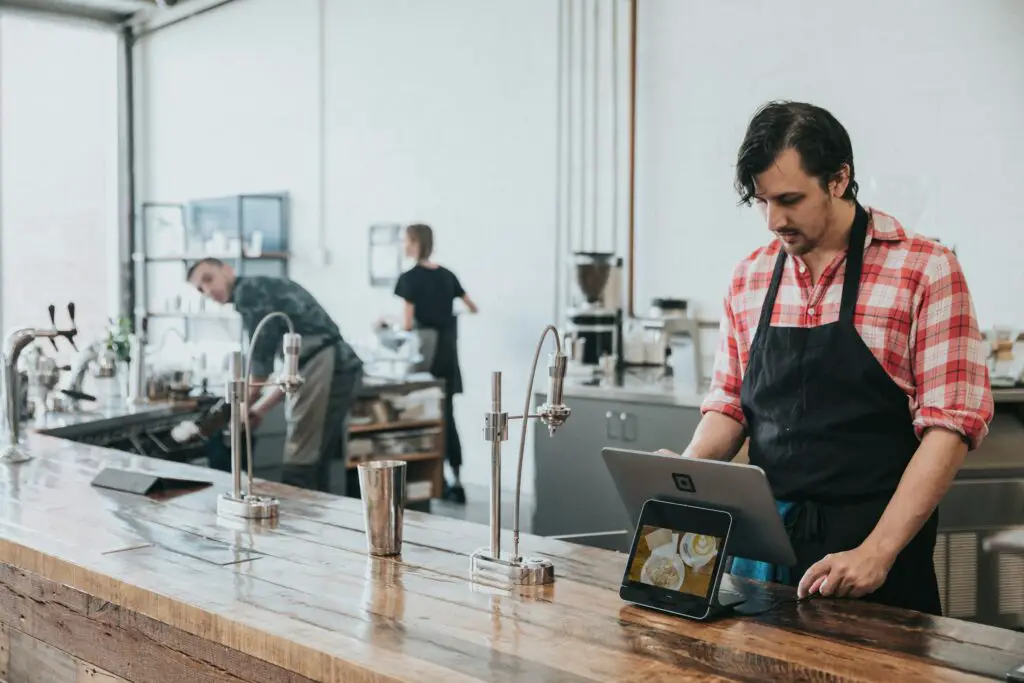
Installing a POS System
A good POS system does more than process transactions; it can transform how your business operates, providing efficiencies and insights that are invaluable.
The benefits of a robust POS system include streamlined operations, which can lead to faster customer service and reduced waiting times.
This system also integrates inventory management, helping you keep track of your stock levels in real-time, minimizing waste, and ensuring you never run out of your best-selling items.
When selecting a POS system, look for features that cater specifically to the needs of a coffee shop.
These include ease of use, so your staff can operate it efficiently even during busy periods, and integration capabilities with other software, such as accounting programs or customer relationship management systems.
Compatibility with mobile devices is another beneficial feature, allowing orders to be taken at the table or even outside the premises.
Additionally, look for a POS system that offers detailed analytics.
This feature can provide insights into sales trends, peak times, and popular products, enabling you to make informed decisions about staffing, promotions, and stock control.
Data security is also crucial, so ensure the system you choose has strong security measures to protect your business and customer information.
Hiring and Training Staff
Building a successful coffee shop hinges on having a great team.
The process starts with hiring the right people who not only have the skills but also fit the culture of your coffee shop.
When hiring, look for individuals who are not just experienced but are enthusiastic about coffee and customer service.
A positive attitude and a willingness to learn are as important as experience.
During interviews, assess candidates for their ability to work as part of a team and their capability to handle busy periods gracefully.
Once you have your team, training becomes crucial to ensure consistent and excellent service.
Your training program should cover not only the basics of coffee making but also customer service, handling of the POS system, and familiarity with your menu.
Emphasize the importance of customer interaction, as this can significantly enhance the customer experience and boost your reputation.
Additionally, provide ongoing training that includes updates on new products or changes in the menu.
Encouraging your staff to pursue further knowledge in coffee craftsmanship can also be beneficial.
Consider offering opportunities for your team to attend workshops or barista courses.
This investment in your staff not only improves their skills but also helps in retaining them by showing that you value their development and career growth.
7. Marketing and Growth

Crafting a Marketing Strategy
A well-crafted marketing strategy is essential for attracting customers and growing your coffee shop.
Utilize a mix of digital marketing techniques and community engagement to build a strong customer base.
Start with digital marketing.
Establish a compelling online presence. Create a user-friendly website that highlights your menu, location, and unique aspects of your coffee shop.
Utilize social media platforms to connect with your audience.
Regularly post engaging content such as behind-the-scenes looks, new product announcements, and special promotions.
Consider email marketing to keep your customers informed about special events and offers.
Community engagement is equally important.
Participate in local events to raise your shop’s profile.
Sponsor community activities or host coffee appreciation workshops.
These interactions not only increase your visibility but also help build a loyal customer base that feels connected to your brand.
Launching Loyalty Programs and Promotions
Implementing loyalty programs and running effective promotions are powerful strategies to increase customer retention and boost sales at your coffee shop.
Loyalty programs reward repeat customers, encouraging them to keep coming back.
These programs can be as simple as a punch card that offers a free drink after a certain number of purchases, or as sophisticated as a digital app that tracks points and rewards customers with discounts, special offers, or free items.
The benefit of loyalty programs is clear: they make customers feel valued and increase the likelihood of repeat visits.
Promotions are another great way to attract both new and existing customers.
Effective promotional strategies could include offering “happy hour” discounts, limited-time offers on new menu items, or themed events that invite customers to experience something unique at your shop.
Promotions can create buzz and increase traffic, especially during typically slow periods.
Both loyalty programs and promotions not only enhance the customer experience but also serve as marketing tools that can differentiate your coffee shop from competitors.
They are effective ways to engage with your community and keep your brand top-of-mind.
8. Opening Your Coffee Shop

Preparing for the Grand Opening
The grand opening of your coffee shop is a significant event that can set the tone for your business’s future success.
Preparing thoroughly ensures you make a great first impression.
Start with a comprehensive checklist for opening day.
This should include final inspections of equipment and facilities, ensuring all your staff are trained and ready, and confirming that your inventory is fully stocked.
Also, check that all your marketing materials, like banners and signs, are in place.
Make sure your POS system is functioning correctly and that all financial systems are ready for transactions.
Consider implementing soft launch strategies before the official opening.
Soft launches involve opening your coffee shop to a limited audience, such as family, friends, or special invitees, before the public opening.
This approach allows you to test your operations in a more controlled environment.
Feedback from these initial visitors can help you fine-tune your service, adjust any menu items, and ensure that your staff are confident in their roles.
It also helps to build initial word-of-mouth buzz about your new coffee shop.
Long-term Success and Adaptation
Ensuring the long-term success of your coffee shop involves continuous monitoring and adapting to changes in the market.
Regularly monitoring your business performance is crucial.
This means keeping an eye on daily sales, customer foot traffic, and staff performance.
Use your POS system’s analytics to track which menu items are popular and which are less so, helping you make informed decisions about what to keep or change.
Also, monitor customer feedback through comment cards, online reviews, and direct conversations to understand their experience and expectations.
Adaptation is key to staying relevant in a competitive market.
Stay informed about new coffee trends and consumer preferences.
For example, if there’s a growing demand for plant-based milk or specialty teas, consider incorporating these into your menu.
Seasonal changes and local events can also provide opportunities to introduce temporary offerings that keep the menu exciting and attract new customers.
By actively engaging with these strategies, you can maintain the health of your business, keep your offerings fresh, and continue to grow your customer base.
This proactive approach will help your coffee shop thrive in an ever-changing market.
Final Words
Opening a coffee shop is an exciting journey that combines passion with entrepreneurship.
We’ve covered essential steps from understanding the market, selecting the right location, and designing your coffee shop, to crafting a compelling menu and developing effective marketing strategies.
Remember to focus on the quality of both your products and customer service, as these are crucial for your success.
As you embark on this venture, stay adaptable and responsive to your customers’ needs and industry trends.
Engage with your community, continuously seek feedback, and be prepared to make changes that enhance your offerings and service.
We wish you all the best as you turn your dream of owning a coffee shop into reality!
FAQ’s
How Much Does It Cost to Open a Coffee Shop?
The cost to open a coffee shop can vary widely based on location, size, and concept.
On average, initial costs range from $50,000 for a small mobile or kiosk setup to $300,000 or more for a full-service coffee shop with seating and a drive-thru.
These figures include expenses for leasing space, renovations, equipment, initial inventory, and licensing fees.
How Profitable Is a Coffee Shop?
On average, a coffee shop generates around $873 in revenue per day, processing about 79 transactions at $11.11 per ticket.
However, this is only an average, and specific figures will vary between establishments.
Do I Need Any Qualifications to Run a Coffee Shop?
No formal qualifications are required to run a coffee shop, but having knowledge of business management, customer service, and basic coffee-making techniques can significantly enhance your success.
Many owners benefit from attending barista courses or participating in hospitality management training.
What is the failure rate of coffee shops?
The failure rate of coffee shops is similar to other small businesses, with some estimates suggesting that about 50% may fail within the first five years.
Success often depends on location, market research, financial planning, and customer service.
What are the monthly expenses of a coffee shop?
The monthly expenses of a coffee shop can range from $13,000 to $65,000, depending on the size and location of the shop, as well as the level of operations.
How many coffees does a coffee shop sell per day?
A busy urban coffee shop might sell anywhere from 200 to 600+ coffees a day, while a small, rural shop might sell fewer than 100.
Knowing the foot traffic and customer patterns in your area can help estimate sales more accurately.
